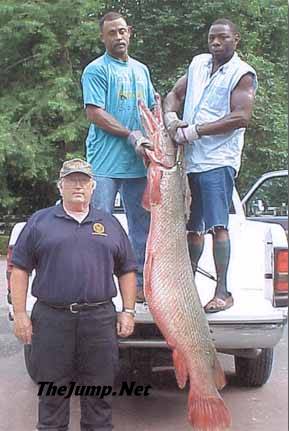Louisiana State Penitentiary at Angola: Inmates Earl Breaux, standing left in the truck, and Randy Ellis show off a 6-foot-9, 164-pound alligator gar caught recently in an overflowing ditch on prison property.
It would have qualified as the second largest alligator gar according to the state record book at the time, but it was not considered because the fish was lassoed with a rope and caught, instead of being caught on rod and reel. Also pictured is Angola Warden Burl Cain.
Population Overview
Louisiana is home to one of the largest alligator populations globally. The state has an estimated 2 million alligators living in the wild, alongside an additional 1 million alligators on farms. This is a significant increase from fewer than 100,000 alligators back in the 1960s. The growth in the population is due to the successful conservation and management efforts spearheaded by the Louisiana Department of Wildlife and Fisheries (LDWF).
The LDWF’s extensive research and careful stewardship have been pivotal in ensuring the resurgence of the alligator population. Through sustainable wild harvest practices and regulated alligator farming, the population has flourished. The state’s efforts have included protecting wetland habitats and implementing strict hunting regulations. Alligator populations in Louisiana are monitored closely, with periodic surveys conducted to ensure the species thrive without impacting their natural habitats negatively.
Alligators are distributed widely across Louisiana, primarily inhabiting the vast coastal marshes. These areas offer about 4.5 million acres of suitable habitat, essential for the alligator’s survival and growth.
Habitat and Distribution
Alligators in Louisiana primarily reside in coastal marshes, swamps, bayous, rivers, lakes, and ponds throughout the state. The coastal marshes provide around 4.5 million acres of suitable habitat, making it the most significant area for alligator habitation. These habitats are crucial for the alligator’s survival, offering the necessary conditions for nesting, feeding, and protection.
The Atchafalaya Basin swamp, cypress-tupelo swamps, and various lakes are also vital habitats for alligators in Louisiana. These areas offer diverse environments that support the life cycle of alligators. In deeper waters, we might find mature male alligators and non-breeding females, while nesting females, juveniles, and hatchlings are often seen in shallower marshes with dense vegetation. These varied habitats ensure that alligators have the resources they need for growth and reproduction.
Understanding where alligators live in Louisiana helps in managing their population and mitigating potential human-alligator conflicts. By preserving these natural habitats and ensuring minimal human interference, Louisiana has managed to maintain a healthy alligator population.
Human Interactions and Safety
Alligators generally avoid humans but can become dangerous if provoked or if humans encroach on their territory. During mating season, from April to June, alligators are particularly territorial and aggressive, posing increased risks to humans.
Safety measures are crucial to prevent dangerous interactions with alligators. It is important not to feed alligators, as this can make them lose their natural fear of humans, leading to more frequent and potentially dangerous encounters. Keeping a safe distance from alligators and avoiding swimming in areas known for high alligator activity are essential precautions.
If an alligator poses a threat, it should be reported to the LDWF, which manages nuisance alligators through removal and relocation programs. These programs ensure that alligators are moved away from populated areas, reducing the risk of human-alligator conflicts.
Precautionary Measures
Lake Martin, Caddo Lake, and the coastal marshes are some of the most alligator-infested areas. Staying vigilant and observing safety measures can significantly reduce the risk of dangerous encounters.
People should avoid swimming or allowing pets to swim in waters known to be inhabited by alligators. It is crucial to be cautious near the water’s edge, especially during dawn and dusk when alligators are most active. These simple yet effective precautionary measures can help ensure safety while enjoying Louisiana’s natural beauty.
Reporting any threatening alligator behavior to the LDWF is essential. The department’s nuisance alligator management program ensures that dangerous alligators are promptly removed and relocated.
Last Words
With millions of alligators in the wild and on farms, these reptiles are an integral part of the state’s ecosystem. Encounters between humans and alligators are common due to extensive wetlands. Safety precautions are essential to minimize risks. Avoid swimming in known alligator habitats, and be cautious near water, especially at dawn and dusk.

